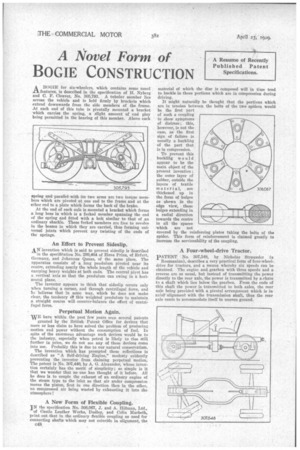A Novel Form of
Page 72

If you've noticed an error in this article please click here to report it so we can fix it.
BOGIE CONSTRUCTION
ABOGIE for six-wheelers, which contains some novel .features, is described in the specification of H. Nyberg and C. F. Cleaver, No. 305,793. A tubular member lies across the vehicle and is held firmly by brackets which extend downwards from the side members of the frame. At each end of this tube is pivotally mounted a bracket which carries the spring, a slight amount of end play being permitted in the bearing of this member. Above each
spring and parallel with its two arms are two torque members which are pivoted at one end to the frame and at the other end to a plate which forms the back of the brake.
At the end of each axle is mounted a bracket which forms a long boss in which is a forked member spanning the end of the spring and fitted with a bolt similar to that of an ordinary shackle. These forked members are free to revolve in the bosses in which they are carried, thus forming universal joints which prevent any twisting of the ends of the springs.
An Effort to Prevent Sideslip.
AN invention which is said to prevent sideslip is described in the specifitation No. 299,464 of Hans Prinz, of Erfurt, Germany, and Johannes Quaas, of the same place. The apparatus consists of • a long pendulum pivoted near its centre, extending nearly the whole length of the vehicle and carrying heavy weights at both ends. The central pivot has a vertical axis so that the pendulum can swing in it horizontal plane.
The inventor appears to think that sideslip occurs only when turning a corner, and through centrifugal force, and he believes that in some way, which he does not make clear, the tendency of this weighted pendulum to maintain a straight course will counter-balance the effect of centrifugal force.
Perpetual Motion Again.
WE have within the past few years seen several patents
granted by the British Patent Office for devices that more or less claim to have solved the problem of producing motion and power without the consumption of fuel. In spite of the enormous advantage such devices would be to the industry, especially when petrol is likely to rise still further in price, we do not see any of these devices come into use. Probably this is due to our natural conservatism.
The invention which has prompted these reflections is described as "A Self-driving Engine," modesty evidently preventing the inventor from claiming perpetual motion. The patent is No. 307,440, by A. G. Alexander, whose invention certainly has the merit of simplicity; so simple is it that we wonder that no one has thought of it before. All he does is to couple the exhaust of an ordinary engine of the steam type to the inlet so that air under compression moves the piston, first in one direction then in the other, no compressed air being wasted by exhausting it into the atmosphere I
A New Form of Flexible Coupling.
IN the specification No. 308,067, J. and A. Hillman, Ltd., "of Castle Leather Works, Dudley, and Colin Macbeth, peint out that in the ordinary flexible coupling as used for connecting shafts which may not coincide in alignment, the e48 material of which the disc is composed will in time tend to buckle in those portions which are in ccrmpression during driving.
It might naturally be thought that the portions which are in tension between the bolts of the two spiders would be the first part of such a coupling to show symptoms of distress; this, however, is not the case, as the first sign of failure is usually a buckling of the part that is in compression.
• To prevent this bucklifig would appear to be the main object of the present invention ; the outer layer of rubber, outside the layers of textile material, are thickened up in the form of bulges as shown in the edge view, these bulges extending in a radial direction towards the centre in all the spaces which are not covered by the reinforcing plates taking the bolts of the spider. This form of reinforcement is claimed greatly to increase the serviceability of the coupling.
Alr_411111■
A Four-wheel-drive Tractor.
PATENT No. 307,548, by Nicholas Straussler
Roumanian), describes a very practical form of four-wheeldrive for tractors, and a means whereby six speeds can he obtained. The engine and gearbox with three speeds and a reverse are as usual, but instead of transmitting the power directly to the rear axle, the power is transmitted by a,chain to a shaft which lies below the gearbox. From the ends of this shaft the power is transmitted to both axles, the rear axle being provided with a pivotal arrangement which is in ;axial -alignment with the transmission shaft, thus the rear axle cants to accommodate itself to uneven ground.














































































































